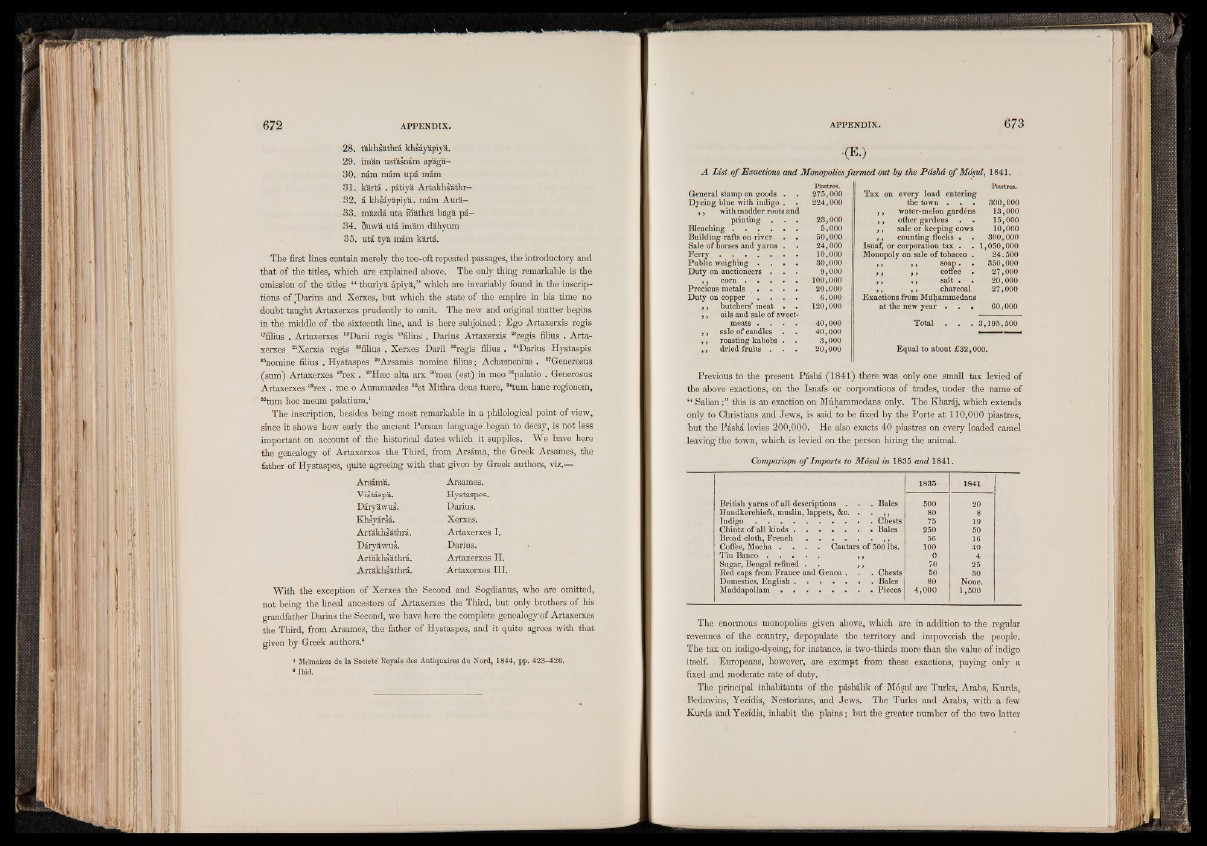
28. t'âkhs'âthrâ khsây'âpiyâ.
29. iman ust'àsnâm ap'âg'â—
30. nâm mâm upâ mâm
31. kartâ . pâtiy'â Artakhsàthr—
32. â khsây'àpiy'â. mâm Aura—
33. m'àzdâ uta m'àthr'â bàgà pâ-
-34. Suw'à uta im'àm dâhyum
35. uta ty'à mâm kartâ.
The first lines contain merely the too-oft repeated passages, the introductory and
that of the titles, which are explained above. The only thing remarkable is the
omission of the titles “ thuriya âpiyâ,” which are invariably found in the inscriptions
of (Darius and Xerxes, but which the state of the empire in his time no
doubt taught Artaxerxes prudently to omit. The new and original matter begins
in the middle of the sixteenth line, and is here subjoined : Ego Artaxerxis regis
'TUrns . Artaxerxes lsDarii regis ,8filius . Darius Artaxerxis “ regis filius . Artaxerxes
“Xerxis regis “ filius . Xerxes Darii “ regis filius . “Darius Hystaspis
“nomine filius . Hystaspes “Arsamis nomine filius ; Achæmenius . S7Generosus
(sum) Artaxerxes !srex . ®Hæc alta arx “ mea (est) in meo “‘palatio . Generosus
Artaxerxes “ rex . me o Auramazdes “ et Mithra deus tuere, “ turn hanc regionem,
“ turn hoc meum palatium.1
The inscription, besides being most remarkable in a philological point of view,
since it shows how early the ancient Persian language began to decay, is not less
important on account of the historical dates which it supplies. We have here
the genealogy of Artaxerxes the Third, from Arsâma, the Greek Arsames, the
father of Hystaspes, quite agreeing with that given by Greek authors, viz.—
Arsâm'à.. Arsames.
Vistâspâ. Hystaspes.
Dâry'àwus. Darius.
Khsyârsâ. Xerxes.
Art'âkhs'àthiâ. Artaxerxes I.
Dâry'àwus. Darius.
Art'àkhsàthrâ. Artaxerxes II.
Artâkhs'âthrâ. Artaxerxes III.
With the exception of Xerxes the Second and Sogdianus, who are omitted,
not being the lineal ancestors of Artaxerxes the Third, but only brothers of his
grandfather Darius the Second, we have here the complete genealogyof Artaxerxes
the Third, from Arsames,' the father of Hystaspes, and it quite agrees with that
given by Greek authors.“
1 Mémoires de la Société Royale des Antiquaires du Nord, 1844, pp. 423-426.
a Ibid.
•(E.)
A List o f Exactions and Monopolies farmed out by the Pasha o f Mdsul, 1841.
General stamp on goods .
Piastres.
275,000
Dyeing blue with indigo . 224,000
, , with madder roots and
printing . 23,000
Blea ching............................. 5,000
Building rafts on river 50,000
Sale of horses and yarns . 24,000
F e r r y ................................... 10,000
Public weighing . . . . 30,000
Duty on auctioneers . 9,000
, , c o r n ........................ 100,000
Precious metals . . 20,000
Duty on copper . . . . 6,000
, , butchers’ meat . 120,000
, , oils and sale of sweetmeats
. . . . 40,000
, , sale of candles . 40,000
, , roasting kabobs . 3,000
,, dried fruits . 20,000
Piastres.
Tax on every load entering
the town . . . 300,000
, , water-melon gardens 13,000
, , other gardens . . 15,000
, , sale or keeping cows 10,000
, , counting.flocks • . 300,000
Isnaf, or corporation tax . . 1,050,000
Monopoly on sale of tobacco . 24,500
, , , , soap. • 350,000
>, , , coffee . 27,000
, , ,, salt . . 20,000
, , , , charcoal 27,000
Exactions from Muhammedans
at the new year . . • 60,000
Total . . . 3,195,500
Equal to about £32,000.
Previous to the present Pasha (1841) there was only one small tax levied of
the above exactions, on the Isnafs or corporations of trades, under the name of
“ Sa l i a nthi s is an exaction on Muhammedans only. The Kharaj, which extends
only to Christians and Jews, is said to be fixed by the Porte at 110,000 piastres,
but the Pasha levies 200,000. He also exacts 40 piastres on every loaded camel
leaving the town, which is levied on the person hiring the animal.
Comparisçm o f Imports to Mosul in 1835 and 1841.
1835 1841
British yarns of all descriptions . . Bales 500 20
Handkerchiefs, muslin, lappets, &c. . ,, 80 8
Indigo . . ................................... . Chests 75 19
Chintz of all k in d s .............................. 250 50
Broad cloth, French . . . . . ü f y 56 16
Coffee, Mocha . . . . Cantars of 500 lbs. 100 40
Tin Banco . . . . . , 0 4
Sugar, Bengal refined . . , 70 25
Red caps from France and Genoa . . Chests 50 30
Domestics, English.............................. . Bales 80 None.
Maddapollam................................... . Pieces 4,000 1,500
The enormous monopolies given above, which are in addition to the regular
revenues of the country, depopulate the territory and impoverish the people.
The tax on indigo-dyeing, for instance, is two-thirds more than the value of indigo
itself. Europeans, however, are exempt from these exactions, paying only a
fixed and moderate rate of duty.
The principal inhabitants of the pashalik of Mosul are Turks, Arabs, Kurds,
Bedawins, Yezidis, Nestorians, and Jews. The Turks and Arabs, with a few
Kurds and Yezidis, inhabit the plains; but the greater number of the two latter